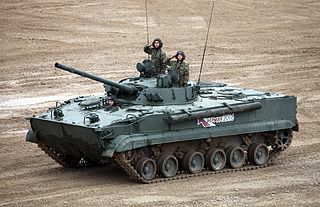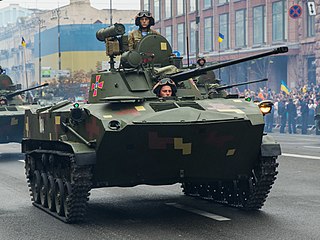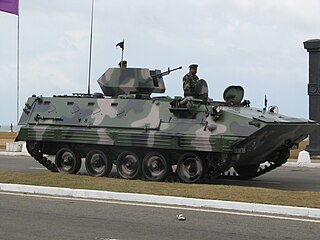
The BMP-3 is a Soviet and Russian infantry fighting vehicle, successor to the BMP-1 and BMP-2. The abbreviation BMP stands for Boevaya Mashina Pekhoty.

The BMP-1 is a Soviet amphibious tracked infantry fighting vehicle that has been in service from 1966 to the present. BMP stands for Boyevaya Mashina Pyekhoty 1, meaning "infantry fighting vehicle, 1st serial model". The BMP-1 was the first mass-produced infantry fighting vehicle (IFV) of the Soviet Union. It was called the M-1967, BMP and BMP-76PB by NATO before its correct designation was known.

The BMD-1 is a Soviet airborne amphibious tracked infantry fighting vehicle (IFV), which was introduced in 1969 and first seen by the West in 1970. BMD stands for Boyevaya Mashina Desanta. It can be dropped by parachute and although it resembles the BMP-1 it is in fact much smaller. The BMD-1 was used as an IFV by the Soviet Airborne Forces (VDV). An improved variant of the BMD-1 was developed, the BMD-2. The BMD-1 also provided a basis for the BTR-D airborne multi-purpose tracked APC.

The BMD-2 is a Soviet airborne infantry fighting vehicle, introduced in 1985. It is a variant of BMD-1 with a new turret and changes to the hull. BMD stands for Boyevaya Mashina Desanta.

The BMD-3 is a light infantry fighting vehicle originating in the Soviet Union that is fully amphibious and air-droppable with crew inside. It is intended to be used by airborne and air assault units. It is not an upgraded BMD-1 but a completely redesigned vehicle with a hydropneumatic suspension, new hull, a more powerful 2V-06-2 diesel engine and fitted with the complete turret of the BMP-2.

The BMPT "Terminator" is an armored fighting vehicle (AFV), designed and manufactured by the Russian company Uralvagonzavod. This vehicle was designed for supporting tanks and other AFVs in urban areas. The BMPT is unofficially named the "Terminator" by the manufacturers. It is heavily armed and armored to survive in urban combat. The AFV is armed with four 9M120 Ataka missile launchers, two 30 mm 2A42 autocannons, two AG-17D grenade launchers, and one coaxial 7.62 mm PKTM machine gun.

The BTR-T was a Russian heavy APC, designed by the Design Bureau of Transport Machine-Building (Omsktransmash) state-run production association.

The WZ-551 is a Chinese wheeled infantry fighting vehicle family. The name WZ-551 actually covers two families of vehicles with the official designations in the People's Liberation Army (PLA) – Type 90 and Type 92. Over 3,000 WZ-551s are in service with the PLA, where they are used by medium mechanized infantry units.

The Shipunov 2A42 is a Soviet/Russian 30 mm autocannon. It is built by the Tulamashzavod Joint Stock Company and named after A. G. Shipunov.

The ZBD-04 or Type 04 is a Chinese infantry fighting vehicle. It bears some external resemblance to the BMP-3, particularly with regards to its turret and main armament; However, the chassis and internal subsystem possesses a different layout. The earliest prototypes received the designation ZBD-97. An improved version, ZBD-04A, is the vehicle currently in service and being produced.

The Norinco Type 89 tracked armoured fighting vehicle is a Chinese armoured personnel carrier. It was developed from the earlier export market Type 85 AFV vehicle. It entered service in the late 1990s and was first shown publicly in 1999. There are approximately 1,000 in service. It has the industrial index of WZ534 and although it was mainly developed for the PLA, there is also an export version YW534.

The Type 05 amphibious armored vehicle is a family of amphibious tracked armored fighting vehicles developed by Norinco for the People's Liberation Army Navy Marine Corps, consisting of two main combat variants — the ZBD-05 infantry fighting vehicle and the ZTD-05 assault vehicle, as well as several support variants based on the ZBD-05. The Type 05s could be launched at sea from an amphibious assault ship over the horizon, and features a hydroplane, a design concept that has been compared to the cancelled United States Expeditionary Fighting Vehicle (EFV) program.

The 2S25 Sprut-SD is a self-propelled anti-tank gun developed and to be manufactured by the Volgograd Tractor Plant to meet the requirements of the VDV. In mid-2001, the Volgograd tractor plant revealed that the development of the 2S25 had lasted several years. In the development of the tank destroyer was used the design of the Bulgarian project Oktopod developed in 1989.

The BMP series were among the first production line infantry fighting vehicles. Included in the series are the mainline BMPs, the airborne variant BMDs, and licensed modified and reverse engineered versions. BMP stands for Boyevaya Mashina Pekhoty, meaning "infantry fighting vehicle". They were initially developed in the 1960s in the Soviet Union.

The Type 08 is a family of eight-wheeled amphibious, modular armored vehicle developed by Norinco for infantry fire support, battlefield logistics, and quick reaction operations. Developed in the early 2000s, the modern Chinese vehicle family were produced for more than 6000 hulls and widely deployed by the People's Liberation Army Ground Force and People's Liberation Army Marine Corps.

The BMD-4 is an amphibious infantry fighting vehicle (IFV) originating from post-Cold War Russia. Originally designated as the BMD-3M, the chassis of the BMD-4 is the same as that of the BMD-3 because it was developed on the same basis. This armored fighting vehicle is one of the lightest in its class, possessing a substantial amount of firepower. The vehicle was designed to transport Russian Airborne Troops (VDV), increasing its mobility, armament, and protection on the battlefield.

The T-15 Armata, with industrial designation "Object 149", is a Russian heavy infantry fighting vehicle first seen in public in 2015 during rehearsals for the Moscow Victory Day Parade. The T-15 concept of a heavy IFV is derived from design of the BTR-T vehicle that never entered military service. As of May 2023, the T-15 Armata has not entered service and the program status is unknown.

The Type 86, also known as WZ501, is a Chinese copy of the Soviet BMP-1 infantry fighting vehicle (IFV).

Borsuk is an amphibious infantry fighting vehicle produced by Huta Stalowa Wola, a part of PGZ. It is designed to replace the BWP-1 IFV that has been in service with the Polish Armed Forces since 1973 but is now obsolete.
The Type 19 Infantry Fighting Vehicle is a family of eight-wheeled amphibious, modular armored vehicle of the People's Republic of China. It improves upon and replaces the Type 08 wheeled armored vehicle family.

























